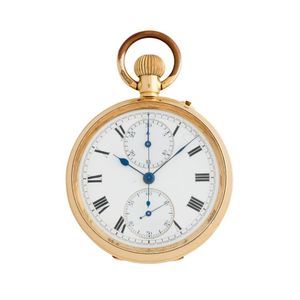1910 18ct Gold Chronograph Pocket Watch with Presentation Inscription
An 18ct gold openface chronograph pocket watch circa 1910, dial: white enamel Roman, fifth seconds ring, subsidiary dial at a 12 for minute recording, constant seconds at 6 blued steel spade hands with centre chronograph seconds, movement: three quarter plate Swiss chronograph, fully jewelled, crown wind, pin set. Case: polished round, front cover with monogram web gold cuvette with presentation inscription from members master carriers members Association of NSW to Mr W.E. Budd, President 1911-1916. Case number: 129422. Dimensions: 50 mm diameter, unsigned. Accessories: none
You must be a subscriber, and be logged in to view price and dealer details.
Subscribe Now to view actual auction price for this item
When you subscribe, you have the option of setting the currency in which to display prices to $Au, $US, $NZ or Stg.
This item has been sold, and the description, image and price are for reference purposes only.
- Circa - A Latin term meaning 'about', often used in the antique trade to give an approximate date for the piece, usually considered to be five years on either side of the circa year. Thus, circa 1900 means the piece was made about 1900, probably between 1895 and 1905. The expression is sometimes abbreviated to c.1900.
- Movement - The technical name for the workings of a clock or watch, and does not include the dial or case.
- Crown Wind - A winding method for a watch, using a knurled or fluted knob, located at 3 o'clock on a wristwatch and 12 o'clock on a pocketwatch.
- Chronograph - A chronograph is a watch that also incorporates the features of a stopwatch, to measure elapsed time. Most chronographs are operated by two buttons, one to start and stop the chronograph second hand, and the other to return that hand to the starting position.
- Subsidiary Dial - On a clock or watch, a subsidiary dial, also called an auxiliary dial, is a dial that is secondary to the main dial and may show seconds, day of the week or month, or strike silent. A subsidiary dial may be within our outside the main dial, and a clock or watch may have several subsidiary dials.
This item has been included into following indexes:
